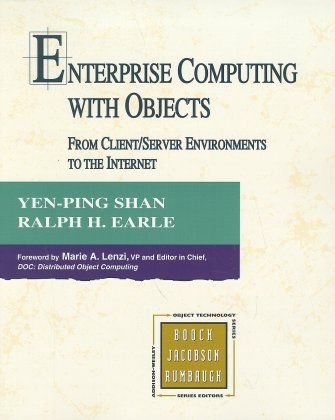
Enterprise Computing with Objects
Addison Wesley (Verlag)
978-0-201-32566-9 (ISBN)
- Titel ist leider vergriffen;
keine Neuauflage - Artikel merken
As the pace of change in business and technology continues to quicken, the business systems that are key to the enterprise's ability to adapt and prosper must also change rapidly. The expansion of enterprise computing into the world of the Internet makes the task of developing, deploying, and maintaining today's information systems even more challenging. With its modular approach to programming and capacity to manage complexity, object technology holds the key to success for enterprise computing to meet these challenges. Enterprise Computing with Objects helps the reader place rapidly evolving technologies-the Internet, the World Wide Web, distributed computing, object technology and client/server systems-in their appropriate context in relation to modern information systems. The authors distinguish what is essential from what is incidental, while imparting a clear understanding of how the underlying technologies fit together. The book examines essential topics, including data persistence, security, performance, scalability, and development tools. Even readers with existing experience in object technology or client/server programming can benefit from the perspectives offered here.With this book as an aid, designers and developers can better transition their information systems into the twenty-first century.
0201325667B04062001
Yen-Ping Shan is chief architect of IBM e-business/Network Computing Framework (NCF) tools and chair of the J20 ANSI Smalltalk committee. He was previously the lead architect of IBM's VisualAge Server and Distributed Smalltalk, and led the development of the first IBM ORB prototype. He has a Ph.D. in computer science from the University of North Carolina at Chapel Hill. Ralph H. Earle has been writing technical documentation and marketing materials at IBM for six years. He has also conducted technical writing seminars for IS departments of major corporations and taught business and creative writing at UNC at Chapel Hill. He holds a Ph.D. from UNC and a B.A. from Stanford University. 0201325667AB04062001
1. Client/Server Computing.
Client/Server Concepts. Client/Server Architecture Models. Distributed Computing and Concurrent Computing. Summary.
2. Object Technology.
A Typical OO System. Object-Oriented Concepts. Advantages of the Object Model. Summary.
3. Integrating Object Technology with Enterprise Systems.
Objectifying Individual Modules. Objectifying the Conventional Architecture Model. Using an OO Language in an OO Architecture Model. Objectifying an Entire System. Summary.
4. Object-Oriented Clients.
A Historical View of Clients. Fat and Slim Clients. Objects in Client Development. Summary.
5. Object-Oriented Services.
Types and Characteristics of Servers. Transaction Servers. Database Servers. Native Servers. Pathways to OO Servers. Summary.
6. Object-Oriented Glue.
The Plumbing. Different Kinds of Glue. Local Glues. Distributed Glues. Summary.
7. Object Persistence and Sharing.
Object Persistence Concepts. Basic Tool Support. Transaction Models. Performance. Reasonable Expectations. Databases. Summary.
8. Objects Across the Internet.
The Impact of the World Wide Web. An Architectural View of the Web. The Internet and OO Client/Server Computing. Summary.
9. End-to-End 00 Enterprise Development.
The Development Models. OO Enterprise Development Tools. Summary.
10. Performance.
Throughput and Response Time. Optimization. Client Performance. Server Performance. Glue Performance. Data Performance. Load Balancing. Summary.
11. The Scaleable OO Enterprise System.
Reliability and Fault Tolerance. System Management. Maintenance & Legacy System Integration. Summary.
12. Security.
An Overview of Client/Server Security. Risk Assessment. Risk Prevention. Security in an OO C/S Environment. Summary.
13. Business Systems.
Groupware. Business System Engineering and Realization. Summary.
14. Some Conclusions and Predictions.
Objects in the Three-Part Model. Objects Across the Enterprise. An Ever-Evolving Technology.
Abbreviations.
Glossary.
References and Further Reading.
Index. 0201325667T04062001
| Erscheint lt. Verlag | 3.2.1998 |
|---|---|
| Verlagsort | Boston |
| Sprache | englisch |
| Maße | 190 x 235 mm |
| Gewicht | 781 g |
| Themenwelt | Informatik ► Software Entwicklung ► Objektorientierung |
| ISBN-10 | 0-201-32566-7 / 0201325667 |
| ISBN-13 | 978-0-201-32566-9 / 9780201325669 |
| Zustand | Neuware |
| Haben Sie eine Frage zum Produkt? |
aus dem Bereich


